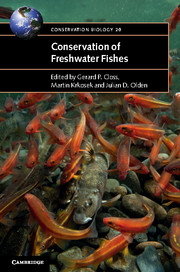Book contents
- Frontmatter
- Contents
- List of contributors
- Preface
- 1 Lost fishes, who is counting? The extent of the threat to freshwater fish biodiversity
- 2 Why are freshwater fish so threatened?
- 3 Climate change effects on freshwater fishes, conservation and management
- 4 Challenges and opportunities for fish conservation in dam-impacted waters
- 5 Chemical pollution
- 6 Multiple stressor effects on freshwater fish: a review and meta-analysis
- 7 Infectious disease and the conservation of freshwater fish
- 8 Non-indigenous fishes and their role in freshwater fish imperilment
- 9 Riparian management and the conservation of stream ecosystems and fishes
- 10 Fragmentation, connectivity and fish species persistence in freshwater ecosystems
- 11 Conservation of migratory fishes in freshwater ecosystems
- 12 Protecting apex predators
- 13 Artificial propagation of freshwater fishes: benefits and risks to recipient ecosystems from stocking, translocation and re-introduction
- 14 Freshwater conservation planning
- 15 Sustainable inland fisheries – perspectives from the recreational, commercial and subsistence sectors from around the globe
- 16 Understanding and conserving genetic diversity in a world dominated by alien introductions and native transfers: the case study of primary and peripheral freshwater fishes in southern Europe
- 17 Maintaining taxonomic skills; the decline of taxonomy – a threat to fish conservation
- 18 Synthesis – what is the future of freshwater fishes?
- Index
- References
9 - Riparian management and the conservation of stream ecosystems and fishes
Published online by Cambridge University Press: 05 December 2015
- Frontmatter
- Contents
- List of contributors
- Preface
- 1 Lost fishes, who is counting? The extent of the threat to freshwater fish biodiversity
- 2 Why are freshwater fish so threatened?
- 3 Climate change effects on freshwater fishes, conservation and management
- 4 Challenges and opportunities for fish conservation in dam-impacted waters
- 5 Chemical pollution
- 6 Multiple stressor effects on freshwater fish: a review and meta-analysis
- 7 Infectious disease and the conservation of freshwater fish
- 8 Non-indigenous fishes and their role in freshwater fish imperilment
- 9 Riparian management and the conservation of stream ecosystems and fishes
- 10 Fragmentation, connectivity and fish species persistence in freshwater ecosystems
- 11 Conservation of migratory fishes in freshwater ecosystems
- 12 Protecting apex predators
- 13 Artificial propagation of freshwater fishes: benefits and risks to recipient ecosystems from stocking, translocation and re-introduction
- 14 Freshwater conservation planning
- 15 Sustainable inland fisheries – perspectives from the recreational, commercial and subsistence sectors from around the globe
- 16 Understanding and conserving genetic diversity in a world dominated by alien introductions and native transfers: the case study of primary and peripheral freshwater fishes in southern Europe
- 17 Maintaining taxonomic skills; the decline of taxonomy – a threat to fish conservation
- 18 Synthesis – what is the future of freshwater fishes?
- Index
- References
Summary
ECOLOGICAL IMPORTANCE OF RIPARIAN HABITATS TO FRESHWATER ECOSYSTEMS
Riparian areas are the terrestrial environment adjacent to water that both influences and is influenced by the aquatic feature (Gregory et al., 1991; Naiman et al., 2010). Riparian areas along streams provide shade, sources of wood and organic matter, contribute to bank stability, filter sediments, take up excess nutrients from groundwater inputs, and other key processes that protect freshwaters (e.g. Naiman et al., 2010; Richardson & Danehy, 2007; Figure 9.1). Riparian areas also increase biodiversity through habitat complexity and close juxtaposition of aquatic and terrestrial environments (Quinn et al., 2004; Naiman et al., 2010). Alterations to riparian areas, despite their small area relative to the landscape, have disproportionate effects on habitats and fish communities (Naiman et al., 2010; Wipfli & Baxter, 2010). Key habitat losses and alterations are derived from modification of riparian areas by reducing instream habitat complexity (Bilby & Ward, 1989; Fausch & Northcote, 1992; Naiman et al., 2010), diminishing the productive basis of freshwater food webs (Belsky et al., 1999; Quinn et al., 2004), increasing nutrient, contaminant and sediment intrusion (Muscutt et al., 1993; Daniels & Gilliam, 1996; Nguyen et al., 1998; Waters, 1999).
Riparian and freshwater ecosystems are typically tightly coupled, especially in their natural states, and the linkages that couple them frequently exert strong influence on their associated invertebrate and fish fauna (e.g. Gregory et al., 1991; Naiman et al., 2010). Riparian habitats, and the condition of these habitats, further plays a key role in the ecology of these fresh waters, influencing critical processes such as water, nutrient and sediment delivery and dynamics; prey resources for fish and other consumers, and other organic materials exchanged between aquatic and terrestrial habitats (Nakano et al., 1999; Naiman et al., 2010); light and water temperature dynamics that in turn affect food web processes and fish metabolism and growth; aquatic physical habitat (wood); and terrestrial consumers that prey upon fishes (Bisson & Bilby, 1998; Naiman et al., 2010; Wipfli & Baxter, 2010). These processes in turn directly or indirectly influence fishes in freshwater systems (Wang et al., 2001; Pusey & Arthington, 2003; Allan, 2004; Richardson et al., 2010a).
- Type
- Chapter
- Information
- Conservation of Freshwater Fishes , pp. 270 - 291Publisher: Cambridge University PressPrint publication year: 2015
References
- 1
- Cited by



